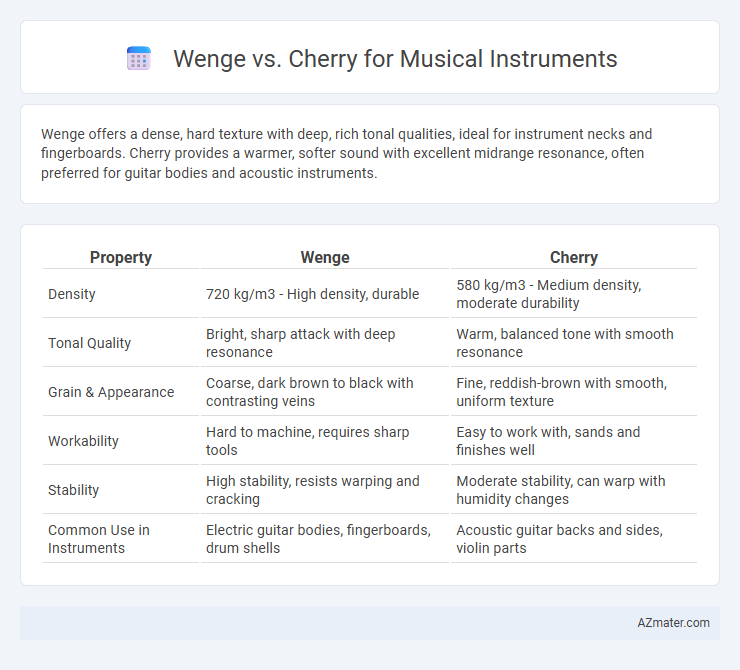Wenge offers a dense, hard texture with deep, rich tonal qualities, ideal for instrument necks and fingerboards. Cherry provides a warmer, softer sound with excellent midrange resonance, often preferred for guitar bodies and acoustic instruments.
Table of Comparison
| Property | Wenge | Cherry |
|---|---|---|
| Density | 720 kg/m3 - High density, durable | 580 kg/m3 - Medium density, moderate durability |
| Tonal Quality | Bright, sharp attack with deep resonance | Warm, balanced tone with smooth resonance |
| Grain & Appearance | Coarse, dark brown to black with contrasting veins | Fine, reddish-brown with smooth, uniform texture |
| Workability | Hard to machine, requires sharp tools | Easy to work with, sands and finishes well |
| Stability | High stability, resists warping and cracking | Moderate stability, can warp with humidity changes |
| Common Use in Instruments | Electric guitar bodies, fingerboards, drum shells | Acoustic guitar backs and sides, violin parts |
Introduction to Wenge and Cherry Tonewoods
Wenge and Cherry are popular tonewoods known for their distinct acoustic properties in musical instruments. Wenge offers a dark, dense grain structure producing warm, rich midrange tones with strong sustain, commonly used in guitar necks and fingerboards. Cherry wood provides a balanced sound with smooth highs and pronounced lows, favored for its resonant quality and attractive reddish hue in acoustic and electric instrument bodies.
Origin and Availability of Wenge and Cherry
Wenge wood, sourced primarily from Central African countries like the Democratic Republic of Congo and Cameroon, is prized for its dense grain and deep, dark coloration, making it a distinctive choice for musical instruments such as guitar bodies and fingerboards. Cherry wood, native to North America and parts of Europe, offers a warm reddish-brown hue and consistent availability, favored for its ease of workability and tonal warmth in instrument crafting. Wenge's limited regional availability and higher cost contrast with Cherry's widespread supply and affordability, influencing manufacturers' material selection based on project scope and budget.
Physical Properties: Density, Hardness, and Grain
Wenge wood boasts a density of approximately 720-820 kg/m3, providing exceptional hardness and durability ideal for musical instruments requiring structural strength and resistance to wear. Cherry wood, with a density around 580-700 kg/m3, offers a softer, more resonant quality favored for tonewoods in guitars and violins, enhancing warmth and richness in sound production. The tight, interlocking grain of Wenge contrasts with Cherry's smooth, fine-grain pattern, impacting both aesthetic appeal and the tactile experience of the instrument.
Acoustic Characteristics and Sound Profiles
Wenge offers a dark, rich tone with strong midrange presence and pronounced low frequencies, making it ideal for bass guitars and drums due to its deep resonance and sustain. Cherry wood provides a warm, balanced sound with clear, bright highs and a smooth midrange, favored in acoustic guitars and violins for its dynamic response and clarity. Both woods contribute distinct acoustic characteristics that influence the instrument's tonal warmth and projection, with Wenge emphasizing depth and power while Cherry highlights brightness and articulation.
Workability and Crafting Considerations
Wenge wood offers exceptional durability and a coarse texture, making it ideal for robust musical instruments but presenting moderate challenges in fine detailing due to its hardness and grain irregularities. Cherry wood, known for its smooth grain and easy workability, allows artisans to craft intricate designs with precision, producing instruments with warm tones and a refined finish. Selecting between Wenge and Cherry depends on the desired balance between structural strength and ease of shaping for instrument makers.
Durability and Longevity in Musical Instruments
Wenge offers superior durability and resistance to wear, making it ideal for musical instruments that endure frequent handling and environmental changes. Cherry wood, while prized for its warm tone and attractive aging, is softer and more susceptible to dents and scratches over time. The longevity of wenge in musical instruments often surpasses cherry, providing extended lifespan and consistent performance in demanding playing conditions.
Aesthetic Appeal: Color and Grain Patterns
Wenge offers a deep, dark brown color with dramatic black streaks that create a bold, exotic look for musical instruments, making it ideal for striking visual impact. Cherry wood features a warm reddish-brown hue that matures to a rich amber with age, providing a classic and elegant aesthetic favored in traditional instrument designs. Both woods display unique grain patterns--Wenge's coarse texture contrasts with Cherry's smooth, fine grain--impacting the instrument's visual texture and overall artistic expression.
Common Instrument Applications for Wenge and Cherry
Wenge wood is highly valued for musical instruments such as electric guitar fingerboards and drum shells due to its dense, durable, and resonant properties that produce rich tonal quality and excellent sustain. Cherry wood is commonly used in acoustic guitar bodies and piano veneers, offering a balanced warmth and smooth midrange resonance that complements stringed and keyboard instruments. Both woods contribute to instrument aesthetics and sound characteristics, but Wenge's hardness suits percussive elements while Cherry's workability benefits crafted acoustic sound chambers.
Price and Sustainability Factors
Wenge wood is typically more expensive than cherry wood due to its rarity and exotic appeal in musical instrument construction. Cherry offers a more affordable, sustainable option as it is widely available and grows faster, making it a preferred choice for eco-conscious luthiers. Sustainability ratings favor cherry because responsibly managed cherry forests regenerate quicker, reducing environmental impact compared to slower-growing wenge trees.
Choosing Between Wenge and Cherry for Your Instrument
Wenge offers a dense, heavy tone with strong midrange presence, making it ideal for bass guitars and instruments requiring deep, punchy sound. Cherry wood provides a balanced sound profile with warm, rich overtones and a smooth finish, often chosen for guitars that emphasize versatility and aesthetic appeal. Selecting between Wenge and Cherry depends on desired tonal qualities and instrument weight, with Wenge favoring powerful resonance and Cherry enhancing midrange clarity and visual appeal.

Infographic: Wenge vs Cherry for Musical Instrument
 azmater.com
azmater.com